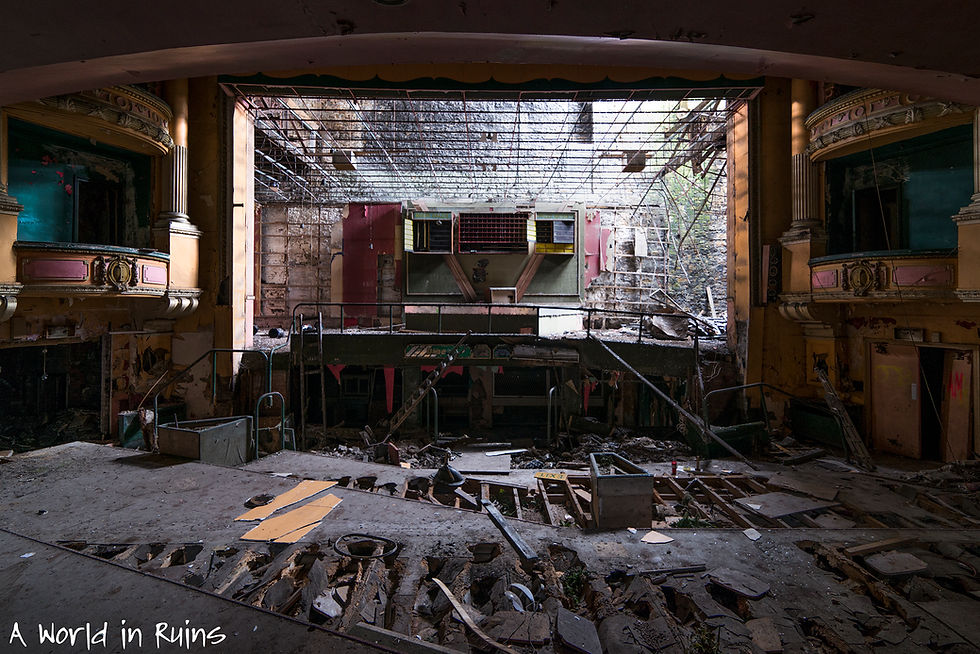

Burnley Empire Theatre. 2018



















Visited on a freezing cold snowy Sunday morning with Scrappy NW and Katy. Long overdue visit this one but access isn't always possible. Inside its dark and decrepit yet enough remains to get an idea of how it looked when it was in full flow. The stage area was a no go as it has now collapsed. Structuraly it was fairly sound even in the upper areas. Things were made to last in 1894 obviously.
Theatres have so much history and are always wonderful places to explore and photograph even if their condition is so poor. On with some history.
HISTORY
The Burnley Empire Theatre has a profoundly poignant history that starts in the 19th Century when it was first designed by GB Rawcliffe in 1894. Owned and managed by WC Horner, it was a theatre of high regard and continued to such following works in 1911, when the auditorium was redesigned by Bertie Crewe, well respected architect, much of whose work is no longer standing – pulled down to make way for housing, shops or other amenities, or victims of the war that destroyed so many beautiful buildings.
The interior boasts ‘two slightly curved wide and deep balconies, terminating in superimposed stage boxes framed between massive Corinthian columns supporting a deep cornice. Segmental-arched proscenium, with richly decorated spandrels and heraldic cartouche. Side walls feature plaster panels, pilasters and drops. Flat, panelled ceiling with circular centre panel and central sun burner. Restrained heraldic and Greek plasterwork on balcony and box fronts’ .
The Theatre opened on Monday the 29th of October 1894 with a variety show and could originally seat 1,935 people.
During its time as a theatrical venue, Charlie Chaplin, Margot Fonteyn and Gracie Fields are just a few of the names to have appeared on the now broken stage.
'The Stage' magazine reported on the opening of the Empire Theatre, Burnley in their November 1st 1894 edition saying:
'On Monday was opened for the first time the new Empire Theatre of Varieties at Burnley. Although of a plain and unpretentious character both internally and externally, the place is fitted up with the most modern appliances necessary for the protection of the public as well as for their entertainment. The stage and its fittings are of the most complete description, containing all the usual paraphernalia of a first class theatre.
The auditorium consists of stalls and pit on the ground floor, with balcony and gallery over, accommodating altogether about 1,500 persons. At the back of the pit and each gallery is a promenade. Each gallery has an independent stone staircase two yards wide (being twelve inches over the regulation width).
The stage is very roomy, with a capital opening, and fitted up with all the modern appliances, traps &c., and with a large scene dock. The dressing-rooms are very comfortable, and will be appreciated by the artists.
A crowded audience greeted the overture and the rise of the curtain on the opening night, and a somewhat lengthy programme was satisfactorily gone through. The artists engaged are Miss Jenny Valmore (who was compelled to sing five songs), J. C. Rich, Graceful Gertrella, Barcello and Millay, Miss Nellie Lovell, the Sisters Paris, Catawhela, Frank Coyne, and O'Conner and Brady.'
In 1911 the respected Theatre Architect, Bertie Crewe reconstructed the auditorium with a new seating capacity of 2,100, and it is Crewe's auditorium that remains to this day despite several changes of use and recent serious neglect.
In 1938 The Theatre was converted for cinema use by the Architects Lewis and Company of Liverpool, and the seating capacity was reduced to 1,808 in the process.
Like so many other Theatres around the Country the Empire was eventually converted for Bingo use in 1970 but even this ceased in 1995 and the Theatre, despite being a Grade II Listed building, has been empty ever since and is in serious decline, and listed as one of the Theatres Trust's buildings at risk.
In 2017, a viability study was commissioned by a stakeholder group which included the Burnley Empire Theatre Trust, Burnley Borough Council, the University of Central Lancashire. However, in August 2017 it was reported by The Lancashire Telegraph that the plans to save Burnley's Empire Theatre had taken a huge blow after a study showed it would not be financially viable if it reopened.
The results of the viability study showed the Grade II-listed building would cost more than £5million to be brought back to life.
Cllr Shah Hussain, who represented the area on Burnley Council, said at the time: "I can understand where the council is coming from and I don't think it is particularly viable for a theatre when there is already one in Burnley. It's not like in the glory days of the 1940s and 1950s when it was much more popular. It's sadly something of a luxury and it is really unfortunate, but it is a luxury in times of austerity we cannot afford. People on the streets of Burnley say it is a dangerous building and needs pulling down and turning into something else."
The main parts of the building have no ownership and have fallen under the jurisdiction of the Duchy of Lancaster for disposal.
As of March 2018 the Theatre still stands decaying.


